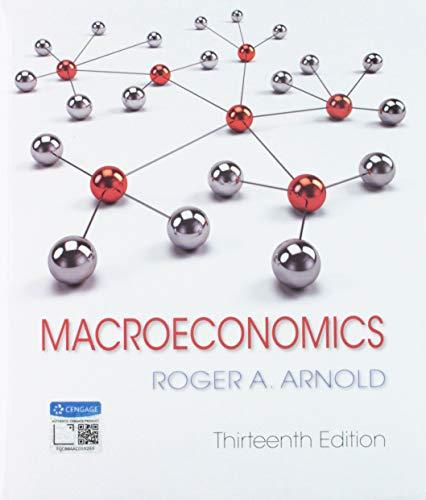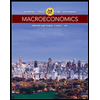
Bundle: Macroeconomics, 13th + Aplia, 1 Term Printed Access Card
13th Edition
ISBN: 9781337742375
Author: Roger A. Arnold
Publisher: Cengage Learning
expand_more
expand_more
format_list_bulleted
Question
Chapter 13, Problem 8WNG
To determine
The change in money supply.
Expert Solution & Answer
Trending nowThis is a popular solution!

Students have asked these similar questions
3. Answer the following questions about external wealth.
a. Home has external wealth of $100 million in period t. In t+1, Home purchases $160
million foreign assets, and Foreign purchases $120 million in Home assets. Assume a
world interest rate of 10% per annum. Compute the "change" in external wealth at t+1 for
Home.
b. A country's external wealth was -$1.5 billion at the end of 2015, and its trade balance
was $750 million in 2016. Assume the world interest rate is 5% per annum. What is the
"value" of a country's external wealth at the end of 2016?
1. The table below shows a country's hypothetical national income and product accounts data.
Category
Consumption (personal consumption expenditures)
Investment (gross private domestic investment)
Government consumption (government expenditures)
Exports
Imports
Net Factor Income from Abroad
Net unilateral transfers
Billions of Dollars
8,000
1,300
2,100
900
1,750
+45
-20
a. Compute the following accounts using the information in the table:
Gross national expenditure (GNE)
. Trade balance (TB)
•
Gross domestic product (GDP)
•
Gross national income (GNI)
.
Gross national disposable income (GNDI)
Current account (CA)
b. Derive the current account identity using the national income identity. Are savings greater
than or smaller than investment in this country? The national income identity is:
GNDIGNE + CA, GNE = C + G + I.
4. Assume that a country produces an output Q of 50 every year. The world interest rate is 10%.
Consumption C is 50 every year, and I = G = 0. There is an unexpected drop in output in year
0, so output falls to 28 and is then expected to return to 50 in every future year. If the country
desires to smooth consumption, how much should it borrow in period 0? What will the new
level of consumption be from then on?
Chapter 13 Solutions
Bundle: Macroeconomics, 13th + Aplia, 1 Term Printed Access Card
Ch. 13.1 - Prob. 1STCh. 13.1 - Prob. 2STCh. 13.1 - Prob. 3STCh. 13.3 - Prob. 1STCh. 13.3 - Prob. 2STCh. 13.3 - Prob. 3STCh. 13.3 - Prob. 4STCh. 13 - Prob. 1QPCh. 13 - Prob. 2QPCh. 13 - Prob. 3QP
Ch. 13 - Prob. 4QPCh. 13 - Prob. 5QPCh. 13 - Prob. 6QPCh. 13 - Prob. 7QPCh. 13 - Prob. 8QPCh. 13 - Prob. 9QPCh. 13 - Prob. 10QPCh. 13 - Prob. 11QPCh. 13 - Prob. 12QPCh. 13 - Prob. 1WNGCh. 13 - Prob. 2WNGCh. 13 - Prob. 3WNGCh. 13 - Prob. 4WNGCh. 13 - Prob. 5WNGCh. 13 - Prob. 6WNGCh. 13 - Prob. 7WNGCh. 13 - Prob. 8WNGCh. 13 - Prob. 9WNGCh. 13 - Prob. 10WNG
Knowledge Booster
Similar questions
- 2. Show how each of the following would affect the following US balance of payments: trade balance (TB), net factor income abroad (NFIA), net unilateral transfers (NUT), financial account (FA), and capital account (KA). Identify which specific account is affected in each case (e.g., +$10 in TB). Note that the sum of the balance of payment accounts is zero. Example: A California computer manufacturer purchases a $50 hard disk from a Malaysian company, paying the funds from a bank account in Malaysia. Answer: The US imports a hard disk from Malaysia: TB = $50 The US draws a foreign asset to pay for the import (less external asset): FA = +$50. (Note: The balance of payment identity holds: CA + FA (+KA) = −- $50 + $50 = 0. No KA in this example.) a. A US tourist in Japan sells his iPod to a local resident for yen worth $100. (hint: A US tourist obtains Japanese currency.) b. A US owner of Honda shares receives $10,000 in dividend payments, which are paid into a Tokyo bank. c. The central…arrow_forwardMark's Pizza Enter George's Pizza Stay Out Advertise $50, -$2 $175, $0 Do Not Advertise $150, $15 $100, $0 In their quest to maximize combined total profits, Mark and George's Pizzas find themselves at a critical juncture. As they carefully evaluate the potential outcomes and weigh their strategic options, the future of Moncton's pizza industry hangs in the balance. Let's imagine both players are analyzing the payoff matrix seeking the optimal combination of actions that will yield the highest collective profit. What actions maximize their combined total profits? a. Mark's Pizza to "Advertise" and George's Pizza to "Stay Out". b. Mark's Pizza to "Do Not Advertise" and George's Pizza to "Stay Out" C. Mark's Pizza to Do Not Advertise" and George's Pizza to "Enter" d. Mark's Pizza to "Advertise" and George's Pizza to "Enter"arrow_forwardWith your team I would like you to complete the following questions after please post your replies and we will discuss in class Choose a financial instrument or market (such as stocks, bonds, insurance, cash, gold, bitcoin). Explain how investments work for the individual investor mainly yourself. With the current market upheaval and uncertainty what would you and your team consider the best options for investment. Consider the idea of short term investing vs long term investing, laddering, safe haven, liquidity, and risk) Consider Roth IRA vs traditional IRA, ETF's, CD's, Mutual Funds. Always consider taxes and inflation your return should always be greater then inflation and taxes.arrow_forward
- Short Description Fiscal Policy Graph Details Shown is a Fiscal Policy diagram with the variable Real GDP (billions of dollars) on the x-axis and the variable Price Level on the y-axis. The x-axis is scaled from 0 to 800 billion dollars with an increment of 40 billion dollars, and the y-axis is scaled from 30 to 150 units with an increment of 5 units. Object Details On the graph we have:Four Line Objects:An upward sloping Aggregate Supply, AS line with two endpoints:Point 1 at (160, 70)Point 2 at (720, 140)A downward sloping Aggregate Demand, AD1 line with two endpoints:Point 1 at (80, 110)Point 2 at (640, 40)A vertical Long-run Aggregate Supply, LRAS with two endpoints:Point 1 at (400, 145)Point 2 at (400, 30)A downward sloping Aggregate Demand, AD line with two endpoints:Point 1 at (720, 60)Point 2 at (160, 130)Two Reference Points:Lines AS, AD, and LRAS intersect at (400, 100)Lines AS and AD1 intersect at (280, 85) a. How much does aggregate demand need to change to restore the…arrow_forwardFiscal Policy Graph Details Shown is a Fiscal Policy diagram with the variable Real GDP (billions of dollars) on the x-axis and the variable Price Level on the y-axis. The x-axis is scaled from 0 to 1000 billion dollars with an increment of 50 billion dollars, and the y-axis is scaled from 0 to 180 units with an increment of 10 units. Object Details On the graph we have:Four Line Objects:An upward sloping Aggregate Supply, AS line with two endpoints:Point 1 at (200, 40)Point 2 at (800, 160)A downward sloping Aggregate Demand, AD line with two endpoints:Point 1 at (200, 160)Point 2 at (800, 40)A downward sloping Aggregate Demand, AD1 line with two endpoints:Point 1 at (350, 170)Point 2 at (900, 60)A vertical Long-run Aggregate Supply, LRAS line with two endpoints:Point 1 at (500, 170)Point 2 at (500, 0)Two Reference Points:Lines AS and AD1 intersect at (600, 120)Lines AS, AD, and LRAS intersect at (500, 100) a. How much does aggregate demand need to change to restore the…arrow_forwarda. How much does aggregate demand need to change to restore the economy to its long-run equilibrium? $ billion b. If the MPC is 0.6, how much does government purchases need to change to shift aggregate demand by the amount you found in part a? $ billion Suppose instead that the MPC is 0.95. c. How much does aggregate demand and government purchases need to change to restore the economy to its long-run equilibrium? Aggregate demand needs to change by $ billion and government purchases need to change by $ billion.arrow_forward
- Price P 1. Explain the distinction between outputs and outcomes in social service delivery 2. Discuss the Rawlsian theory of justice and briefly comment on its relevance to the political economy of South Africa. [2] [7] 3. Redistributive expenditure can take the form of direct cash transfers (grants) and/or in- kind subsidies. With references to the graphs below, discuss the merits of these two transfer types in the presence and absence of a positive externality. [6] 9 Quantity (a) P, MC, MB MSB MPB+MEB MPB P-MC MEB Quantity (6) MCarrow_forwardDon't use ai to answer I will report you answerarrow_forwardIf 17 Ps are needed and no on-hand inventory exists fot any of thr items, how many Cs will be needed?arrow_forward
- Exercise 5Consider the demand and supply functions for the notebooks market.QD=10,000−100pQS=900pa. Make a table with the corresponding supply and demand schedule.b. Draw the corresponding graph.c. Is it possible to find the price and quantity of equilibrium with the graph method? d. Find the price and quantity of equilibrium by solving the system of equations.arrow_forward1. Consider the market supply curve which passes through the intercept and from which the marketequilibrium data is known, this is, the price and quantity of equilibrium PE=50 and QE=2000.a. Considering those two points, find the equation of the supply. b. Draw a graph for this equation. 2. Considering the previous supply line, determine if the following demand function corresponds to themarket demand equilibrium stated above. QD=.3000-2p.arrow_forwardSupply and demand functions show different relationship between the price and quantities suppliedand demanded. Explain the reason for that relation and provide one reference with your answer.arrow_forward
arrow_back_ios
SEE MORE QUESTIONS
arrow_forward_ios
Recommended textbooks for you
 Economics (MindTap Course List)EconomicsISBN:9781337617383Author:Roger A. ArnoldPublisher:Cengage Learning
Economics (MindTap Course List)EconomicsISBN:9781337617383Author:Roger A. ArnoldPublisher:Cengage Learning

 Macroeconomics: Private and Public Choice (MindTa...EconomicsISBN:9781305506756Author:James D. Gwartney, Richard L. Stroup, Russell S. Sobel, David A. MacphersonPublisher:Cengage Learning
Macroeconomics: Private and Public Choice (MindTa...EconomicsISBN:9781305506756Author:James D. Gwartney, Richard L. Stroup, Russell S. Sobel, David A. MacphersonPublisher:Cengage Learning Economics: Private and Public Choice (MindTap Cou...EconomicsISBN:9781305506725Author:James D. Gwartney, Richard L. Stroup, Russell S. Sobel, David A. MacphersonPublisher:Cengage Learning
Economics: Private and Public Choice (MindTap Cou...EconomicsISBN:9781305506725Author:James D. Gwartney, Richard L. Stroup, Russell S. Sobel, David A. MacphersonPublisher:Cengage Learning

Economics (MindTap Course List)
Economics
ISBN:9781337617383
Author:Roger A. Arnold
Publisher:Cengage Learning



Macroeconomics: Private and Public Choice (MindTa...
Economics
ISBN:9781305506756
Author:James D. Gwartney, Richard L. Stroup, Russell S. Sobel, David A. Macpherson
Publisher:Cengage Learning

Economics: Private and Public Choice (MindTap Cou...
Economics
ISBN:9781305506725
Author:James D. Gwartney, Richard L. Stroup, Russell S. Sobel, David A. Macpherson
Publisher:Cengage Learning
